Castellania (Valletta)
| Castellania | |
|---|---|
| Kastellanja | |
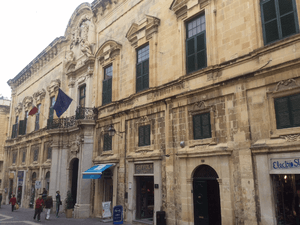 Façade of the Castellania | |
| Former names |
Palazzo del Tribunale Palais de Justice Gran Corte della Valletta |
| Alternative names | Castellania Palace |
| General information | |
| Status | Intact |
| Type | Courthouse |
| Architectural style | Baroque |
| Location | Valletta, Malta |
| Address | No. 11–19, Merchants Street |
| Coordinates | 35°53′48″N 14°30′45″E / 35.89667°N 14.51250°ECoordinates: 35°53′48″N 14°30′45″E / 35.89667°N 14.51250°E |
| Current tenants | Ministry for Health, the Elderly and Community Care |
| Construction started | 1757[lower-alpha 1] |
| Opened | 15 November 1760 |
| Owner | Government of Malta |
| Technical details | |
| Material | Limestone (façade decorated with marble) |
| Floor count | 2 |
| Design and construction | |
| Architect |
Francesco Zerafa Giuseppe Bonici |
The Castellania (Maltese: Il-Kastellanja; Italian: La Castellania), officially known as Castellania Palace (Italian: Palazzo Castellania; Maltese: Il-Palazz Castellania), is a former courthouse and prison in Valletta, Malta. It was built by the Order of St. John between 1757[lower-alpha 1] and 1760, on the site of an earlier courthouse which had been built in 1572.
The building was built in the Baroque style to designs of the architects Francesco Zerafa and Giuseppe Bonici. It is a prominent building in Merchants Street, having an ornate façade with an elaborate marble centrepiece. Features of the interior include a former court hall, a chapel, prison cells, a statue of Lady Justice at the main staircase and an ornate fountain in the courtyard.
From the late 18th to the early 19th century, the building was also known by a number of names, including the Palazzo del Tribunale, the Palais de Justice and the Gran Corte della Valletta. By the mid-19th century the building was deemed too small, and the courts were gradually moved to Auberge d'Auvergne between 1840 and 1853. The Castellania was then abandoned, before being briefly converted into an exhibition centre, a tenant house and a school.
In 1895, the building was converted into the head office of the Public Health Department. The department was eventually succeeded by Malta's health ministry (currently known as the Ministry for Health, the Elderly and Community Care), which is still housed in the Castellania. The building's ground floor contains a number of shops, while Sir Themistocles Zammit's laboratory on the second floor is open to the public by appointment as The Brucellosis Museum.
History
Background
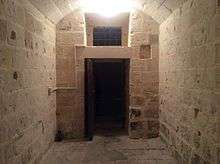
The Magna Curia Castellaniæ, also known as the Gran Corte della Castellania (English: High Court of the Castellania[1]), was a tribunal in Malta during the rule of the Order of St. John. The courts followed the Sicilian legal system, and the tribunal was headed by a Castellano or Preside, who was a knight of the Order. It included two judges, one for civil and one for criminal cases. There was also a Cancelliere, who was responsible for receiving and preserving judicial acts, registering the sentences meted out by the judges and supervising the other workers in the courts. There was a Gran Visconte, and Capitani di notte who implemented the sentences. Other workers included an official who saw that prisoners were treated fairly, those who were responsible for the archives and advocates for legal aid.[2][3]
The tribunal was established by Grand Master Juan de Homedes y Coscon in 1543,[4] and it was initially housed in a building in Birgu. After the Order moved their headquarters to Valletta, a new Castellania was built in the new capital in 1572, during the magistracy of Grand Master Jean de la Cassière.[2] Meanwhile, the original Castellania in Birgu was converted into the Inquisitor's Palace in 1574.[5] Apart from a courthouse, the Castellania also served as a prison where suspects and convicts were imprisoned.[2]
Construction and use as a courthouse
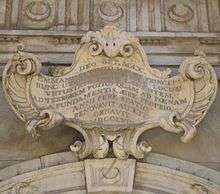
The original Castellania of Valletta was demolished in the mid-18th century on orders of Grand Master Manuel Pinto da Fonseca.[6][7] A new Baroque building was constructed on its site,[8] with works commencing in 1757.[lower-alpha 1] Throughout the course of construction, prisoners were held in a torre near Valletta's Porta Reale,[11] probably the tower of Saint James Cavalier.[12][13] The new Castellania was built to a design by the architect Francesco Zerafa,[8] but he died before its completion, so he was substituted by the architect Giuseppe Bonici. The edifice was completed in 1760, with its chapel being consecrated on 15 November of that year.[14] During the 18th century, the building was also called the Palazzo del Tribunale.[15]
Some of the marble used in the façade was cannibalized from the ruins of the Temple of Proserpina, an ancient Roman temple in Mtarfa which had been discovered in 1613.[16][17] A craftsman who worked on the decorative sculpture of the Castellania's chapel was Maestro Giovanni Puglisi, a Neapolitan buonavoglia.[9][11] Ironically, he would become the first man to be convicted of murder and sentenced to death by hanging in the Castellania.[18][19]
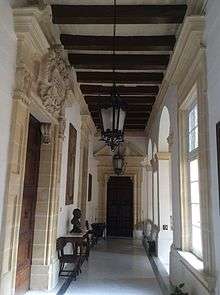
Following the Rising of the Priests in 1775, three of the rebellion's leaders were executed without receiving fair trial. The death penalty was signed by the Castellano under the orders of Grand Master Francisco Ximenes de Texada.[2] Prior to judgement, some of the priests and clerics were locked up in the secretive prisons near the courtroom of the Castallania, some at the Castellania dungeons, and in other Valletta buildings. All those arrested were recorded on the Libro del Carcerati Della Magna Curia Castellania. Among them was Gaetano Mannarino, the leader of the rebellion.[13]
Malta was invaded by the French First Republic in June 1798, and the Order was expelled from the island, resulting in the French occupation of Malta. The French reformed the legal system, with the Magna Curia Castellaniæ being replaced by the Tribunale Provisorio and the Tribunale Civile di Prim'Instanza.[20] The post of Castellano was abolished, and judges were nominated by the Commission de Gouvernement. During the years of French occupation, the building was known as the Palais de Justice.[2]
After a successful Maltese uprising against French rule, in 1800 Malta became a British protectorate,[2] and the law was once again reformed, with the Castellania becoming known as the Gran Corte della Valletta.[20] The patriot Mikiel Anton Vassalli was imprisoned at the Castellania from 16 September 1800 until he was exiled on 15 January 1801.[21][22][23] Like other public buildings, the Castellania was closed down during the plague outbreak of 1813–14, and it was only used for emergency cases relating to the plague itself.[2] When the plague ended, the Castellania was once again used as a courthouse and gaol for accused who were still awaiting trial.[24]
While the Castellania was in use as a courthouse and prison, parts of the building were also used for a number of other purposes. For example, it housed the Monte di Pietà until 1773,[14] and the office of the Deputy Inspector General of Executive Police in the early 19th century.[25]
The building was no longer regarded as being adequate to function as a courthouse by 1840,[2] and that year the Civil Courts were moved to Auberge d'Auvergne. The courts of criminal jurisdiction and the office of the police were also moved to the auberge in 1853,[26] so the Castellania was abandoned. The building later housed an exhibition centre, a tenant house and a Government High School for Girls.[27]
Department and Ministry for Health
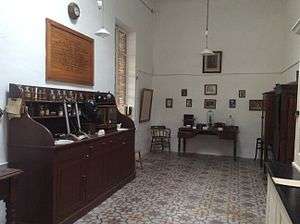
The building became the seat of the Medical Officer in 1885.[27] On 10 April 1895 Gerald Strickland converted the building into the head office of the Public Health Department,[14] which was later renamed the Medical and Health Department.[28] Between 1904 and 1906, the Malta Fever Commission worked in the Castallania,[29][30] and on 14 June 1905 the physician Sir Themistocles Zammit discovered the Mediterranean strain of brucellosis while working there.[31]
A laboratory on the Castellania's second floor which was used by the Malta Fever Commission was restored and converted into The Brucellosis Museum in 1980, and it is now open to the public by appointment.[32] Since the British period some of the prison cells were modified and converted into government offices and at present still serve this purpose.[33] Other parts of the Castellania's interior, including the chapel and some of the prison cells, were restored in the 1990s.[9] There were further plans to restore the façade, but nothing materialized.[34][35]
The building now houses Malta's health ministry, which has been known by a number of names throughout the years (currently Ministry for Health, the Elderly and Community Care).[2] The ground floor houses a number of shops.[36] The rest of the building is not normally open to the public, except for some special occasions such as the Notte Bianca.[37]
The building was included on the Antiquities List of 1925, as La Castellania.[38] It is now a Grade 1 national monument,[36] and it is also listed on the National Inventory of the Cultural Property of the Maltese Islands.[10]
Architecture
Exterior
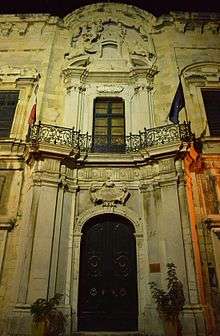
The Castellania is built in the Baroque style[10] and it is a prominent building in the area.[39][40] It is two stories high, being built on three sides of a small courtyard at the rear. Although the building has an asymmetrical plan, the main façade in Merchants street is symmetrical, and it includes an ornate centrepiece with clustered pilasters at the corners of the building.[41] The centrepiece includes an arched main doorway, a jotting out symmetric triple concave,[42] above which is a cornice[42] and an iron-railed balcony which opens into the piano nobile.[10] Heraldic crescents from Pinto's coat of arms decorate the main portal,[7] and a commemorative plaque with the following inscription is found beneath the balcony. It reads:[14][43][44]
DEO OPT. MAX.
EMMANUEL PINTO M.M. ET PRINCEPS
HUNC UTRIUSQUE JUSTITIÆ LOCUM
VETUSTATE PROPE LABENTEM,
AD TERROREM POTIUS, QUAM AD POENAM
A FUNDAMENTIS, ÆRE PROPRIO
ANNI FERE SPATIO
RENOVAVIT AUXIT,
ORNAVIT
MDCCLVIII
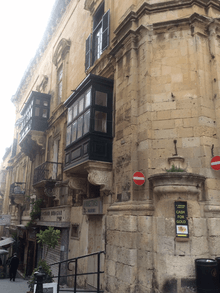
The balcony is topped by allegorical figures of Justice and Truth, as well as sculptures of a winged female figure and a putto.[10] The empty spaces between these figures probably contained Pinto's bust and coat of arms, but they were removed during the French occupation of Malta or in the early 19th century.[36] Some parts of the sculptures, such as the scales held by Lady Justice, are now missing.[41]
The ground floor in Merchants Street was designed so as to house eight shops, four on each side of the main doorway, and eight square windows on the top floor, one above each shop.[41] The windows are also decorated with the symbolic crescents of Pinto.[7] The side façade along St. John's Street is not as ornate as the main façade, and it contains a set of wooden and open balconies. The entrance to the Castellania's prison cells is located in the side façade.[41]
The building's corner between Merchants and St. John's streets contains a cylindrical pedestal which is about 3 m (9.8 ft) high. This originally served as a pillory,[45] where prisoners would be publicly humiliated. More serious offenders were whipped[46] or tortured using the corda at this pillory.[41][47] Louis de Boisgelin, the historian of the Order, says amid the last three days of the Maltese carnival the locals used to recite a Roman tradition at the Castellany by dangling a stone above the pillory (instead of a human) and hit it which symbolised a temporal halt of punishment during those days.[48]
An iron hook is affixed into the wall of the Castellania close to the pillory. According to local legend, the hook might have been used to lift the largest bell of the nearby Saint John's Co-Cathedral, but this is now regarded as unlikely.[49] The hook was most probably used to secure prisoners to the Castellania's pillory.[50][51] In 1803, Horatio Nelson allegedly passed through the hook in a dare, and the hook became known as Nelson's Hook after the Battle of Trafalgar.[52] It became a tradition for Royal Navy sailors to bet and buy drinks for shipmates who managed to pass through the hook. Junior officers allegedly had a good chance of promotion if they passed through the hook.[53][54][55]
Interior
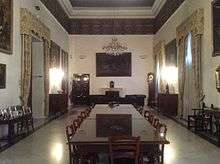
The interior of the Castellania contains offices, a court hall, a chapel and prison cells.[10] The most decorated room in the building is the Sala Nobile (Noble Hall) on the first floor, which was originally the court hall[56] and which is now used as a board room.[37] This room has coats of arms of the Castellani depicted on the upper side of the walls.[28][36] A large statue representing Lady Justice or Astraea wearing a blindfold and holding weighing scales stands near the staircase which led to the courtrooms.[9][57][58] The marble statue stands on a limestone pedestal, and its sculptor is unknown.[59]
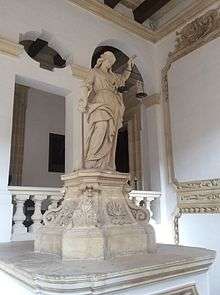
The chapel was dedicated to Our Lady of Sorrows (also called the Madonna di Pietà or Mater Dolorosa).[11][60] After being deconsecrated in the late 19th century, the room was used for other purposes[28] and only the limestone altar, which was retrieved during restoration works in 1991,[9] still remains from the chapel's original interior.[11] An ornate fountain is located at the building's main courtyard.[36]
A number of prison cells are found in the Castellania. The cells close to the court rooms hosted new cases and also those awaiting execution.[61] Several other cells are located at the rear of the building, and they are surrounded by a courtyard.[36] These cells housed inmates who had to serve a short sentence of less than eight days,[61] usually due to unpaid rent or accumulated debts.[2] Prisoners with longer sentences were usually sent to other prisons, usually the Gran Prigione.[61] The minor inmates at the Castellania were the ones who took care of the general maintenance, cleaning and repair works of the building, while guards were responsible for the allocation of tasks and observing their performance.[62] Some historical graffiti made by prisoners can be found at and next to the prison cells.[36]
Legacy
The building was colloquially referred to in Maltese as il-Kistlanija.[63] It inspired the saying għandu wiċċ l-għatba tal-Kistlanija, which is translated as "he has the face of the Castellania's doorstep". This referred to a shameless person showing few or no expressions.[64]
Commemorative coins
La Castellania was depicted on two commemorative coins minted in 2009 by the Central Bank of Malta. The coins show part of the building's façade on the reverse and the coat of arms of Malta on the obverse.[40][65]
Notes
References
- ↑ Savona-Ventura, Charles (2005). Contemporary Medicine in Malta [1798–1979]. Malta: P.E.G. Ltd. p. 61. ISBN 1326648993.
- 1 2 3 4 5 6 7 8 9 10 Boffa, Christa (8 July 2016). "Palazz Castellania". Illum (in Maltese). Archived from the original on 30 July 2016.
- ↑ "National Archives of Malta announce completion of the digitisation of the magnia curia castellaniae". The Malta Independent. 5 August 2015. Archived from the original on 4 August 2016.
- ↑ "The Magna Curia Castellania" (PDF). Melitensia. The Malta Study Center: 5. Spring 2012. Archived from the original (PDF) on 2 April 2016.
- ↑ "The Inquisitor's Palace". Times of Malta. 4 December 2012. Archived from the original on 4 March 2016.
- ↑ Owen's African and Middle East Commerce & Travel and International Register. Owen's Commerce & Travel, Limited. 1963. p. 885.
- 1 2 3 Kininmonth, Christopher (1979). Malta and Gozo. Cape. p. 131.
- 1 2 Ellul, Joseph (1996). The Grandmaster's Palace & The Gobelin Tapestries. Malta: Joseph Ellul. p. 27. ISBN 9781903799109.
- 1 2 3 4 5 Guillaumier, Alfie (2005). Bliet u Rħula Maltin. Klabb Kotba Maltin. p. 937. ISBN 99932-39-40-2.
- 1 2 3 4 5 6 "Castellania" (PDF). National Inventory of the Cultural Property of the Maltese Islands. 28 December 2012. Archived from the original (PDF) on 15 March 2016.
- 1 2 3 4 Attard, Christian (2013). "The sad end of Maestro Gianni". Treasures of Malta (56): 47–51.
- ↑ Godwin, George Nelson (1880). A Guide to the Maltese Islands. Malta: Paolo Bonavia. p. 123.
- 1 2 Borg-Muscat, David (1933). "Reassessing the September 1775 Rebellion: A Case of Lay Participation or a 'Rising of the Priests'" (PDF). Melita Historica. 3 (2): 242–252. Archived from the original (PDF) on 16 April 2016.
- 1 2 3 4 Denaro, Victor F. (1958). "Houses in Merchants Street, Valletta" (PDF). Melita Historica. 2 (3): 159–161. Archived from the original (PDF) on 16 April 2016.
- ↑ Scaglione, Giannantonio (2011–2012). "The city of Valletta in an Eighteenth Century Map" (PDF). Journal of Maltese History: 16–34. Archived from the original (PDF) on 4 August 2016.
- ↑ Caruana, Antonio Annetto (1882). Report on the Phoenician and Roman antiquities in the group of the islands of Malta. Malta: Government Printing Office. p. 88.
- ↑ Cardona, David (2008–2009). "The known unknown: identification, provenancing, and relocation of pieces of decorative architecture from Roman public buildings and other private structures in Malta". Malta Archaeological Review (9): 43.
- ↑ Degiorgio, Stephen (2010). "Palaces and Lodgings of the Knights of St John at Malta". academia.edu. Retrieved 13 March 2016.
- ↑ Ganado, Albert (2001). Palace of the Grand Masters in Valletta. Fondazzjoni Patrimonju Malti. p. 29. ISBN 99932-10-12-9.
- 1 2 "First original Indexes on line". National Archives of Malta. Archived from the original on 6 August 2016.
- ↑ Cremona, A. (1933). "Mikiel Anton Vassalli" (PDF). Il-Malti (in Maltese). Akkademja tal-Malti. 9 (3): 89. Archived from the original (PDF) on 17 April 2016.
- ↑ "Journal of Maltese Studies" (in Maltese) (23–24). Malta University Press. 1993: 20.
- ↑ "Id-dati ewlenin fil-ħajja ta' Vassalli" (PDF). Journal of Maltese Studies (in Maltese) (23–24): 35. 1993. Archived from the original (PDF) on 15 April 2016.
- ↑ Knepper, Paul (2009). "A few detectives would be very useful: crime, immorality, and policing in Valletta, 1881–1914.". thefreelibrary.com. Journal of Social History. Archived from the original on 6 August 2016.
- ↑ Pericciuoli Borzesi, Giuseppe (1830). The historical guide to the island of Malta and its dependencies. Malta: Government Press. p. 45.
- ↑ Ganado, Albert (28 March 1966). "Law Courts in Valletta". Times of Malta. pp. 39–40.
- 1 2 3 "Castellania Palace" (PDF). Ministry for Health, the Elderly and Community Care. Archived from the original (PDF) on 26 October 2015.
- ↑ Wyatt, H. V. (2000). "Sir Themistocles Zammit: his honours and an annotated bibliography of his medical work" (PDF). Maltese Medical History. 12(1,2) (27): 27–30.
- ↑ Rota, R. (September 2013). "A focus of the History of the Medical Health Inspectorate in Malta" (PDF). Environment Health Directorate, Malta (5): 1–5.
- ↑ "Il-laboratorju ta' Sir Temi Zammit jinfetaħ għall-pubbliku waqt Notte Bianca". TVM (in Maltese). 5 August 2015. Archived from the original on 4 August 2016.
- ↑ Wyatt, H. V. (March 2010). "The Brucellosis Museum in Valletta" (PDF). Malta Medical Journal. 22 (1): 44. Archived from the original (PDF) on 31 July 2016.
- ↑ "Knights' law courts building open for visitors". Times of Malta. 1 October 2009. Archived from the original on 12 August 2016.
- ↑ Malta, Department of Information (1996). Reports on the Working of Government Departments for the Year ... DOP. p. 493.
- ↑ "Debates tal-Kamra tad-Deputati (Rapport Uffiċjali u Rivedut) – Id-disa' Parlament – Seduta Nru. 127" (in Maltese). Parliament of Malta. 22 June 1999. Retrieved 9 August 2016.
- 1 2 3 4 5 6 7 "The Castellania". Malta Environment and Planning Authority. Archived from the original on 12 March 2016.
- 1 2 "Notte Bianca 2012 – 29 September: Invitation to visit Palazzo Castellania during Notte Bianca". Government of Malta. 28 September 2012. Archived from the original on 1 August 2016.
- ↑ "Protection of Antiquities Regulations 21st November, 1932 Government Notice 402 of 1932, as Amended by Government Notices 127 of 1935 and 338 of 1939.". Malta Environment and Planning Authority. Archived from the original on 19 April 2016.
- ↑ Harry, Luke (1960). Malta: An account and an appreciation. Harrap. p. 67.
- 1 2 "Issue Of collector coins featuring 'La Castellania'". The Malta Independent. 23 June 2009. Archived from the original on 4 August 2016.
- 1 2 3 4 5 Thake, Conrad (16 May 2008). "The Architectural legacy of Grand Master Pinto (2)". The Malta Independent. Archived from the original on 1 August 2016.
- 1 2 Ellul, Michael (1982). "Art and Architecture in Malta in the Early Nineteenth Century" (PDF). Melitensia Historica: 3. Archived from the original (PDF) on 11 October 2016.
- ↑ Ferris, Achille (1881). Memorie dell' inclito Ordine gerosolimitano esistenti nelle isole di Malta. Tip. di C. Busuttil. p. 197.
- ↑ Morana, Martin (2011). Bejn Kliem u Storja (in Maltese). Malta: Books Distributors Limited. ISBN 978-99957-0137-6. Archived from the original on 5 October 2016.
- ↑ Playfair, Robert Lambert (1881). "Handbook to the Mediterranean". 2. J. Murray: 184.
- ↑ Touring Editore (2007). Malta – Guide Verdi Europa (in Italian). Touring Editore. p. 64. ISBN 88-365-3317-5.
- ↑ Cassar-Pullicino, Joseph (1992). Studies in Maltese Folklore. Malta University Press. p. 50.
- ↑ de Kerdu, Pierre-Marie-Louis de Boisgelin (1805). Ancient and Modern Malta (Vol. 1[-2]: 6). R. Phillips. p. 93.
- ↑ Cauchi, Kenneth (26 May 2012). "The hook in St John's Street (2)". Times of Malta. Archived from the original on 29 September 2015.
- ↑ "One World – Protecting the most significant buildings, monuments and features of Valletta (36)". Times of Malta. 12 August 2008. Archived from the original on 4 March 2016.
- ↑ Bonney, Thomas Gray. The Mediterranean: Its Storied Cities and Venerable Ruins, Vol. 1. Library of Alexandria. p. 243. ISBN 1-4655-7163-9.
- ↑ Tarpey, Brian N. (31 July 2004). "'Nelson's Hook'". Times of Malta. Archived from the original on 19 January 2016.
- ↑ Formosa, Francis (22 May 2012). "The story behind the hook". Times of Malta. Archived from the original on 5 November 2015.
- ↑ Formosa, Francis (26 May 2012). "The hook in St John's Street (1)". Times of Malta. Archived from the original on 6 August 2016.
- ↑ "The hook at Triq San Gwann". Malta Environment and Planning Authority. 2012. Archived from the original on 17 October 2016.
- ↑ "Invitation To visit Palazzo Castellania during Notte Bianca". The Malta Independent. 29 September 2011. Archived from the original on 30 July 2016.
- ↑ "Wirja u Open Day f'Palazz Kastellanja". iNews Malta (in Maltese). 24 October 2014. Archived from the original on 1 September 2016.
- ↑ "WIRJA FIL-QORTI L-ANTIKA FL-OKKAŻJONI TAL-JUM EWROPEW DWAR IL-ĠUSTIZZJA". gov.mt (in Maltese). 24 October 2014. Archived from the original on 1 September 2016.
- ↑ Malta u l-Qorti tal-Ġustizzja tal-Unjoni Ewropea (PDF) (in Maltese). Luxembourg: Publications Office of the European Union. 2014. ISBN 978-92-829-1733-6. Archived from the original (PDF) on 3 April 2016.
- ↑ Ciantar, Giovannantonio (1780). Malta Illustrata (in Italian). Malta. p. 343.
- 1 2 3 Zuccagni-Orlandini, Attilio (1842). Corografia fisica, storica e statistica dell'Italia e delle sue isole corredata di un atlante. from Oxford University. p. 667.
- ↑ Cumbo, F. (1844). QR code for Repertorio di proclami, ordinanze, notificazioni ecc. F. Cumbo. p. 181.
- ↑ Cassar Pullicino, Joseph (October–December 1949). "The Order of St. John in Maltese folk-memory" (PDF). Scientia. 15 (4): 160. Archived from the original (PDF) on 17 April 2016.
- ↑ Cachia, Pierre (2011). Exploring Arab Folk Literature. Edinburgh University Press. p. 183. ISBN 978-0-7486-5407-9.
- ↑ "Coins for culture". Times of Malta. 25 June 2009. Archived from the original on 7 September 2016.
Further reading
| Wikimedia Commons has media related to Castellania (Valletta). |
- Graffiti at Castellania prison courtyrad. The Xprunara. Publikazzjonijiet Indipendenza. 2000. pp. 1–44. ISBN 9990941939.
- Knox, Thomas Wallace (1983). The boy travellers in southern Europe : adventures of two youths in a journey through Italy, southern France, and Spain, with visits to Gibraltar and the islands of Sicily and Malta. New York City, Franklin Square: Harper & Brothers. pp. 415, 416. "Relic of the knights", prison life and torture.
- The picturesque Mediterranean, its cities, shores, and islands, with illustrations on wood by J. MacWhirter, A.R.A., J. Fulleylove, R.I., J. O'Connor, R.I., W. Simpson, R.I., W.H.J. Boot, S.B.A., C. Wyllie, E.T. Compton and others. New York Cassell Publishing Company. 1890. p. 48. Book gives details of the strappado, excludes the use of the iron bar or hook, but mentions the use of the window above the pilllory.
- Cassar, Paul (1988). The Castellania Palace: From Law Courts to Guardian of the Nation's Health. Malta: Department of Information.
- Testa, Carmel (1989). The Life and Times of Grand Master Pinto, 1741–1773. Malta: Midsea Books. ISBN 978-99909-93-20-2.
- Malta Calling. University of California: Practical Press Limited. 1942. p. 31.
- Buhagiar, Mario (2009). Essays on the Knights and Art and Architecture in Malta, 1500-1798. Malta: Midsea Books. ISBN 9993272469.
- Muscat, Joseph (1997). Graffiti on the exterior walls of St Paul's Shipwreck church Wied il-Qliegħa Mosta. Melita Historica. 12 (2). pp. 179-194.
- Muscat, Joseph; Cassar, Joanne (1994). The Gozo Prisons Graffiti. Melitensia. p. 246.
- Borg, Charmaine (20 November 2015). Palazzo Castellania. Scribd. Archived from the original on 5 October 2016.
- Scicluna, Sandra (2004). The Prison in Malta: 1850–1870 and 1931–1951. PhD dissertation. University of Leicester. Harvard. Prison was closed in 1850. "Debtors' Prison" transferred to Gran Prigione. p. 60.
- THE SESSIONAL PAPERS PRINTED BY ORDER OF THE HOUSE OF LORDS, OR PRESENTED BY ROYAL COMMAND IN THE SESSION 1839 VOL. VII. Oxford University. 1839. pp. 63-65 (Accounts and Papers: Affairs of the Island of Malta. pp. 317-506).
- Il-Belt (Valletta). Il-Malti. Il-Ghaqda tal-Kittieba tal-Malti. Second Book. 1928. pp. 33-35. Gas Office and other legacies.
- School financial support, at the Castellania.
- 3 large cases of silver (jewels), found at the building, were melted to be used as moneyby the French on 7 October 1798
- portrait of Caterina Vidal. p. 370.
- Museum and dungeons/underground
- On the Path of the Knights of Malta. p. 62.
- Bonello, Giovanni (2007). Notes for a History of the Judiciary at the Time of the Order. judiciarymalta.gov.mt. p. 20-21. (important comment).
